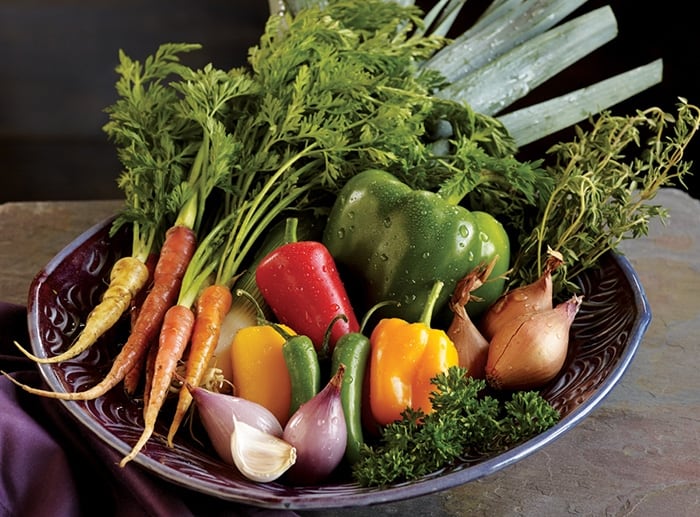
From mirepoix in France to refogado in Brazil, foundational trinities of aromatic vegetables bring flavor to soups, stews, sauces and other dishes worldwide. Aromatics are vegetables that deliver deep, rounded flavor and aroma when heated or crushed. From garlic and onions to chilies and ginger, each vegetable boasts different health benefits and cooking qualities that make it unique.
To create delicious meals by adding flavor instead of fat, sugar or salt, here are some tips for using aromatics.
- For the best flavor and texture, use fresh aromatics. Frozen ones may be too watery.
- Chop and store aromatics in advance to make meal prep quick and easy during the week.
- Chop veggies for even cooking. Hearty vegetables like carrots may require a smaller chop to soften at the same rate as onions, but larger cubes may be appropriate for a soup or stew that will cook longer.
- Handle hot peppers and onions carefully. The oils from these aromatics can irritate your eyes and nose. Wash your hands before touching your face.
- Don’t weigh down your dish with fats and oils. Sauté or sweat vegetables in small amounts of oil, juice, broth or water. To sweat vegetables, cook them in a tightly covered pot. Vegetables will soften without browning.
Carrots
Native to Asia and the Middle East, carrots are tops for beta carotene, which helps regulate the immune system and may reduce risk for certain diseases of aging. Carrots are a good source of fiber, vitamins C and B6 and potassium. Cooking carrots unleashes beta carotene for better absorption.
Celery
Often dismissed as the "negative-calorie vegetable," celery has 15 calories per cup and is a source of vitamins A, C and K and potassium. Celery also provides quercetin, a flavanoid with antioxidant, anti-inflammatory and heart-protecting properties. Cook celery to release its deep, savory flavor or enjoy it raw as a crunchy snack.
Chili Peppers
Native to Central and South America, chili peppers range from mild to fiery hot. Heat intensity is courtesy of the chemical compound capsaicin, which may improve digestion. Smaller peppers are generally hotter. Add peppers to salsas, sauces and entrees for a spicy kick and boost of vitamins A and C.
Garlic
The most pungent of the alliums, enjoy garlic raw or cooked in salads, stir-fries, sauces and stews. Eating garlic regularly may reduce atherosclerosis and the risk of stomach, colorectal and prostate cancers. Garlic's rich phytochemical content delivers its cholesterol-lowering and cancer-fighting characteristics.
Ginger
In its native Southeast Asia and India, fresh ginger completes, with garlic and chili peppers, what's sometimes referred to in culinary circles as a holy trinity of flavor. With a signature spicy fragrance, ginger shines in sweet and savory dishes. It's rich in antioxidants such as 6-gingerol, believed to be responsible for reducing nausea and symptoms of vertigo. Ginger provides vitamin C, magnesium and potassium.
Leeks
With a mild onion flavor, leeks are best cooked. Enjoy leeks grilled, in pasta dishes or as the key ingredient in vichyssoise — a French-style potato soup. Leeks are a natural source of inulin, which supports good gut bacteria. Leeks provide vitamins A and C, folate and manganese.
Onions
A staple in the U.S., onions are an aromatics superstar. High concentrations of allyl sulfides in onions do double duty fighting heart disease and cancer. Onions are a good source of inulin (for a healthy gut), vitamin C, fiber, folate and manganese. Enjoy sweet onions raw in salads and the pungent ones in stews, sauces or roasted.
Parsnips
Traditionally used in Europe to sweeten desserts before sugar became widely available, parsnips are available year-round but are sweetest after a frost. Roast and caramelize parsnips to bring out their natural sweetness. Smaller roots are most flavorful and tender. Good source of vitamin C, folate and fiber.
Peppers
Native to Central and South America, bell peppers come in a range of colors. Green peppers ripen to red and become sweeter. At 30 calories, one red pepper delivers a day's worth of vitamins A and C — a great choice for healthy skin and immune function. Roast, stir-fry or enjoy peppers raw.
Shallots
Traditionally used to flavor French sauces, shallots flaunt a flavor that's between onion and garlic. Shallots may be cooked whole, oven roasted or finely chopped to season salad dressings. Good source of vitamin C, vitamin B6 and manganese.
Scallions
Also called spring or green onions, these alliums have a sweet, delicate onion flavor. Enjoy thin scallions raw in grain or potato salads and salsas. Use thicker, more pungent scallions in pasta dishes, omelets and stir-fries. Low-calorie scallions provide fiber, potassium and vitamin A.








